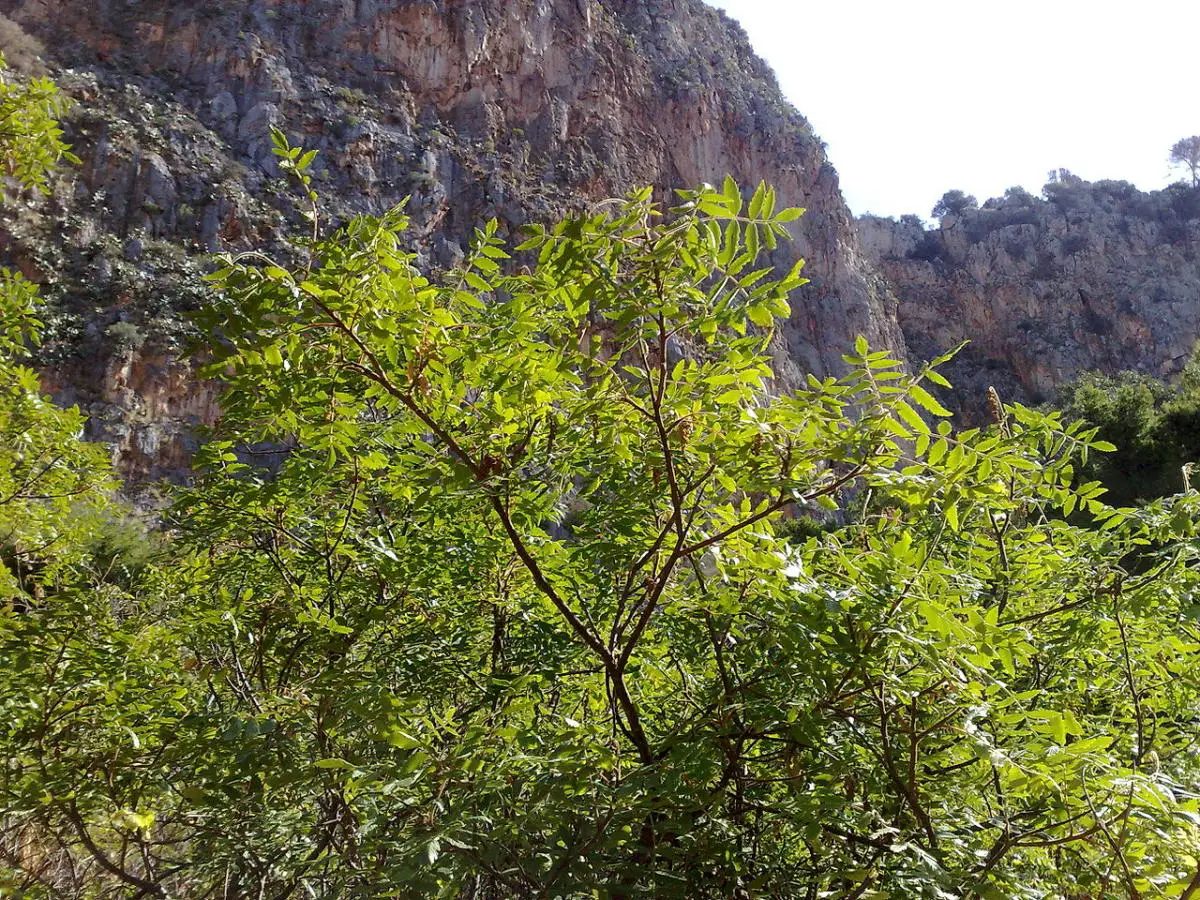
Image – Wikimedia Commons / Dedda7
Plants known as sumac or sumac are trees and shrubs that have a fast growth, and that develop leaves composed of green pinnae. Some species turn reddish in autumn, before entering their winter rest, so they are very interesting to grow in those gardens where you want to see the passing of the seasons.
However, its roots are rhizomatous, so it is important to bear in mind that they have a certain tendency to form colonies of several specimens. But don’t worry because they are plants that tolerate pruning quite wellso that you can grow them anywhere, even in pots.
Origin and characteristics of sumac
These are arboreal and shrubby plants native to the temperate and warm regions of the world that belong to the genus Rhus. They can reach heights between 1 and 10 meters, and their pinnate leaves are arranged in a spiralgiving them a really pretty look. The pinnae are, as we have said before, green in color, although those of certain species, such as Rhus typhinain autumn they turn reddish / orange before falling, and have a serrated or serrated margin.
The flowers are grouped in panicles that can be between 5 and 30 centimeters long. These flowers are very small, measuring about 1 centimeter, and are composed of five greenish, red or cream petals. Once pollinated, the fruits, which are red drupes, form equally dense clusters.
Main species of Rhus
The genus Rhus is made up of more than twenty species, including the following:
rhus coriaria

Image – Wikimedia Commons / Wikimedia Commons
The rhus coriaria is a deciduous shrub native to southern Europe that reaches a height of 1-3 meters. Its leaves are green and soft to the touch, and its yellowish flowers are slightly aromatic.
It has several uses:
- Culinary: the ripe fruits are used as a substitute for lemon (never consume the green ones, as they can be toxic).
- Business: it is widely used in leather tanning, as it has a high tannin content (around 13-28%).
rhus toothed

Image – Wikimedia Commons / Franz Xaver
The rhus toothed It is a deciduous tree that grows between 4 and 6 meters in height originally from South Africa. The leaves are green and have serrated margins; the flowers, on the other hand, are creamy-whitish in color.
rhus glabra

Image – Wikimedia / Superior National Forest
The rhus glabraknown as Carolina sumac or smooth sumac, it is a deciduous shrub that reaches 3 meters in height and it has green flowers. It is native to North America, from southern Canada to northeastern Mexico.
Rhus leptodictya

Image – Wikimedia Commons / JMK
The Rhus leptodictya is an evergreen tree native to Africa that reaches a height of up to 5 meters. Its crown is rounded, and it is populated by pinnate green leaves. The flowers are white, and it produces fruits – berries – that are highly appreciated by some birds.
Rhus typhina

Image – Wikimedia / Daniel Fuchs
The Rhus typhinaknown as Virginia sumac, is a deciduous shrub or tree native to eastern North America. Reaches a height of 3 to 10 metersand its pinnate leaves have a serrated margin. Both the petioles and the branches are covered by numerous reddish hairs.
rhus vernix

Image – Wikimedia / Keith Kanoti
Now this species is no longer within the genus Rhus, but is known as Toxicodendron vernixor by the common name poison sumac. It is a shrub native to the eastern United States, which reaches a height of up to 3 meters. Its leaves are pinnate, with entire margins. Unlike the Rhus, this plant produces gray or white berries, not red.
It is a toxic plant, as its contact with the skin can cause irritation.
What is the care of sumac?
If you would like to have a sumac (Rhus) in your garden or patio, it is important that you take into account some things so that it grows well:
Location
Sumac, regardless of the species grown, it has to be outsidein an area where it gets the sun if possible throughout the day.
As its roots are rhizomatous, it is recommended that it be planted in the ground, at a distance of about 3-5 meters from walls and others so that it can have a good development. But it can be kept in pots without problems, if it is pruned.
Soil or substrate
- the garden: the land has to be fertile and have good drainage since the roots do not support waterlogging.
- Flower pot: must be filled with universal substrate (for sale here!), or with mulch. Also, the pot has to have holes in its base.
Irrigation

Irrigation will be moderate. African species, such as the rhus toothed or Rhus leptodictya they resist drought better than the others, but in general it will be necessary to water an average of 2 times a week during the summer. The rest of the year the waterings will be spaced to prevent the roots from rotting.
Pruning
Sumac pruned in late winter. Remove the branches that have dried and / or broken, and take the opportunity to reduce the length of those that are growing a lot if you think it is necessary.
Put on gloves to keep your hands protected.
Subscriber
You can fertilize your sumac in spring and summer. Use fertilizers such as mulch (for sale here!), humus (for sale here!) or compost for example.
Another option is to use fertilizers, such as one for green plants. Of course, it is necessary that the instructions for use be followed.
Multiplication
It multiplies by seeds in spring, and also by rhizomes in spring-summer.
Rusticity
It depends on the species. For instance, Rhus typhina resists up to -7ºC, and the rhus glabra up to -18ºC.
What did you think of sumac?

